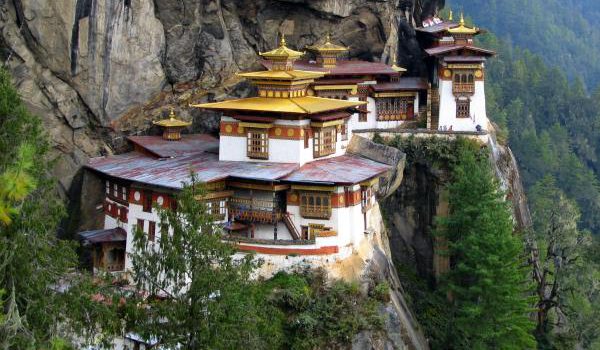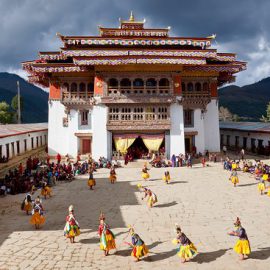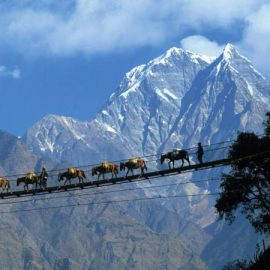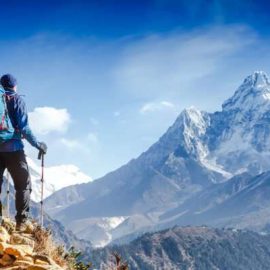
Arrival flight to Bhutan provides the most fascinating view of Himalayan scenic beauty on a clear day. Flying along the Himalayan ranges either from Kathmandu, Kolkata, Bangkok or Delhi is a mesmerizing aeronautical feat and offers exciting descent into the kingdom’s narrow valley of Paro. After coming out of the airport our guide and transport vehicle in waiting will drive you to Thimphu, the capital city of Bhutan and stay overnight in Thimphu.
DAY 2: THIMPHU
Take breakfast and explore the Thimphu valley surrounded by blue pine and temperate evergreen forests. The increasing human settlement has pushed the birding spots at least 8-10 KMs away from the main city and now the ideal areas for birding are around the stream near Motithang and in and around Begana and towards Cheri hillside. Few of the bird species recorded here are: Common Sandpiper (Tringa hypoleucos), Red-rumped Swallow (Hirunda daurica), Sparrow hawk (Accipiter nisus melaschistos), Grackle or Hill Myna (Gracula religiosa) Grey Wagtail (Motacilla caspica), Whitebellied Yuhina (Yuhina xanthoteuca), Upland Pipit (Anthus sylvanus), Plumbeous Redstart (Rhyacornis fuliginosus). Come back to hotel and stay overnight in Thimphu.
DAY 03: Thimphu-Punakha/Wangduephodrang (75km, 2 hours’ drive)
From Thimphu proceed towards Punakha/Wangdue valley after the breakfast. Dochula pass (alt. 3,050M) offers most spectacular view of high peaks of eastern Himalaya. From here the descent to Punakha and Wangduephodrang valley which has the altitude difference of about 1,800m.The route first passes through a temperature type of leafy forest where rhododendron and mongolia bushes grow and then passes to semi tropical zone where orange tree, banana trees and cactuses are found in abundance. In this area the common species of birds seen are: Blackchinned Yuhina (Yuhina nigrimenta), Spotted Dove (Streptopelia chinensis), Blackchinned Babbler (Stachyris pyrrhops), Blackbreasted Sunbird (Aethopyga saturate), Redbreasted Rosefinch (Carpodacus puniceus), Fulvousbreasted Pied Woodpecker (Picoides macei), Large Grey Babbler (Turdoides melcolmi), Himalaya Tree Pie (Dendrocitra vagabunda), Little Bunting (Emberiza striolata). Slatybacked Forktail (Enicurus schistaceus), Whitebreasted Kingfisher (Halcyon smyrnensis), Yellowbilled Blue Magpie (Cissa flavirostris), Grey Heron (Ardea cinerea), Steppe Eagle (Aquila rapax nipalensis), Small Niltava (Muscicapa macgrigoriae), Himalayan Griffon (Gypus himalayensis), Speckled Wood Pigeon (Columbia hodgsonii), GreyTtit (Parus major) and Red crowned Jay (Garrulous glandarius). After the day’s sojourn stay overnight at the hotel in Punakha.
DAY 04: Punakha-Wangdue phodrang/Gangtey (70km, 3hours)
After the breakfast start the journey towards east and we’ll enter the Black Mountain region of Nature Park. The drive is relatively shorter and there are regular stops for birding and photography all along the way as we pass through various villages and forests of different kinds. As we ascend towards the mountain side the road leads to the forests of oak and rhododendrons. once crossing the mountain the broad valley of Phobjikha opens up and is one of the few glacial valleys of Bhutan. During winter season the migrating flocks of black-necked cranes from highlands of Tibetan plateau come to breed and due to which this valley is one of the most important wildlife reserves in the country. Beautiful Gangtey village sits on the ridge overlooking the large green expense of Phobjikha valley below and is a refreshing view for the visitors. Birds species available in this region are: Amur falcon (Falcon vesertinus,) Redmantled Rosefinch (Carpodacus rhodochlamys), firebreasted (Haemmatospiza sipahi), Whitetailed Nuthatch (Sitta Himalayensis), Magpie-Robin (Copsychus saularis), Goldcrest (Regulus), Great peid Hornbill (Buceros bicornis), common hill partrifge (Arborophila torqueola), snow piegeon (Columba Leuconota), Rufousbreasted Accenter (Prunella strophiata), whitebacked munia (Lonchura Striata). After the day’s tour around the valley guests may stay overnight in one of the hotels in Phobjikha.
DAY 05: Gangtay-Trongsa (130 KM, 5 hrs drive)
After the breakfast check out of the hotel and move towards central Bhutan. This stretch covers varied vegetation changes from short evergreen bushes in the Pele Pass to tall, dense, evergreen forest characterized by moss and lichen covered broad leaved trees such as horse chestnuts, laurels, maples and alders. At higher elevation the composition of trees found are fir, spruce, larch, hemlock and juniper. Bamboo is another important habitant bushes in this region with many unique species. This part of the journey is not very prominent birding area but still we get to see few species such as : Himalayan Griffon(Gyps Himalayensis), Himalayan Swiftlet (Collocalia Brevirostries), Lammergeier (Gypaetus barbatus), Snow partridge (Lerwa lerwa), Purple cochoa (Cochoe Purpurea), Scalybreasted Wren Babbler (Pnoepga albiventer), Longtained Minivet (Pericrocotus ethologus), Himalayan Monal Pheasant (Lophophorus Impejanus), Speckled wood piegeon (Columba hodgsonii) and Rufousbellied bulbul (Hypsipetes mcclellandi). Night halt will be at Trongsa after the day’s tiring journey.
DAY 06: Trongsa-Bumthang (Jakar) (68km-3 Hrs Drive)
On this trip of 68km, there is quite a variation in altitude from 2100m in Trongsa to Yotongla pass at 3400m and the then descends to Bumthang valley at 2600m; likewise the vegetation changes from temperate forest of Trongsa to coniferous and mixes alpine of Bumthang. Apart from being one of the most beautiful valleys of the kingdom, Bumthang is also the religious heartland of the nation. The ideal birding spots in this region are before Yotongla pass, farm land in the valleys and the riverside of Chamkhar Chhu River. Few birds of this area are like: Goldcrest (Regulus regulus), Blyths Pipit (Anthus godlewskii), common sandpiper (Tringa Hypoleucos), Little bunting (Emberiza Fucata), Red billed chough (pyrrhocorax graculus) and cormorant (phalacrororax carbo). Guests will stay overnight in hotel at Bumthang.
DAY 07: Bumthang/Ura (50km, 2hours)
Ura is the least and highest valleys of the Bumthang and to reach there the road climbs through amazingly open countryside, occasionally running into forest. Large sheep pastures lands are seen all along the route. There is 3600m high Ura la pass to cross in between and then descends into Ura village with fields and pastures. Perched at an altitude of 3100m, Ura Village has characteristically closed clustered house which is quite unusual in Bhutan. The day is for exploring fascinating Ura Valley and Village around. Overnight stay for the guests will be in the tented accommodation.
DAY 08 & 09: Ura-Limithang (80km, 3 hrs drive).
Leaving behind the relatively dry Ura valley, the route ascends through the forest of gigantic firs, with mixed bushes of rhododendrons. The road for a few kilometers is dangerously steep cliff and scary until we reach the Thrumshingla pass at an altitude of 3,750 m. From this highest pass in the country, the road descends to the village of Sengor, a tiny settlement of wooden shingled roofs and lush fields. This village is also the home to this mountain’s most special bird, Monal Lophophorus Impejanus. These two days explore the wonderfully rich subtropical forests of this area. Trees stretching to the sky high, these forests differ noticeably from those at higher elevations with tall trees sporting magnificent girths supported on huge buttress.
The important species visible in this area are: Black Bulbul (Hypsipetes madagascariensis), Blyth’s pipit (Anthus godlewskii), Bronzed Drongo (Dicrurus aeneus), Gould’s Shortwings (Brachypteryx stellata), Redheaded Bullfinch (Pyrrhula erythrocephala), Speckled Piculet (Picumnus innominatus), Grey Wagtail (Motacilla caspica), Whitethroated Munia (Lonchura malabarica), Whitebrowed Blue Flycatcher (Muscicapa Leucomelanura), Parrotbill (Paradoxornis nipalensis), Honeyguide (Indicator xanthonotus), Redvented Bulbul (Pyconotus cafer), Lesser Racket-Tailed Drongo (Dicrurus remifer), Fantail Warbler (Cisticola exilis) and Rufousthroated Hill Partridge (Arborophila rufogularis). First night stay in the tents and on the 2nd night drive to Mongar town and stay in the hotel over there.
DAY 10. Mongar-Bumthang
After breakfast drive back to Bumthang and if time permits later in the day may go for sightseeing aroung in the Bumthang valley and take rest in the hotel overnight.
DAY 11. Bumthang to Thimphu.
After breakfast drive to drive Thimphu which will take whole day to reach. Lunch will be arranged at Trongsa. Overnight stay in hotel at Thimphu.
Day 12. Thimphu – Paro.
The altitude of Paro valley ranges from 2150M-2,950M and the ideal birding spots are through the farmlands, the lower and upper broadleaved evergreen forests, the riversides, subalpine forest and shrubberies. The valley also possesses wealth of cultural attractions such as Ta Dzong (National Museum), Rinpung Dzong, Kyichu Lhakhang and Taktsang Lhakhang. Some of the recorded bird species in Paro includes: Aberrant Bush Warbler (Cettia flavoivacea), Blyth’s Reed Warbler (Acrocephalus dometorum), Himalayan Whistling Thrush (Mylophonus caeruleus), Common Teal (Ana crecca), Greyheaded Flycatcher Warbler (Seicercus Xanthoschistos), Greenbacked Tit (Parus Monticolus), Hodgson’s Redstart (Phoenicurus hodgsoni), Jungle Crow (Corvus macrorhynchos), Himalayan Brown Dipper (Cinclus pallasi), Crestee Honey Buzzard (Pernis ptilorhyncus), Himalayan Treecreeper (Certhia hamalayana), Hill Pigeon (Colombua rupestris), Rufousbreasted Accentor (Prunella strophiata), Rufous Turtle Dove (Streptoppelia orientailis), Rufousbellied Hawk-Eagle (Hieraaetus Kienerii), Strpethroated Yuhina (Yuhina gularis), Longtailed Minivet (Pericrocotus ethologus).
And if time permits hike to Tiger Nest (Taksang Monastry) which amazingly perches on a rocky cliff and is one of the most visited pilgrimage and touristic places in Bhutan. Overnight stay for the guests will be in a hotel at Paro.
DAY 13: Departs out of Bhutan.
Depending on the time schedule of the departing flight, our guide will see off the guests for onwards journey home.



